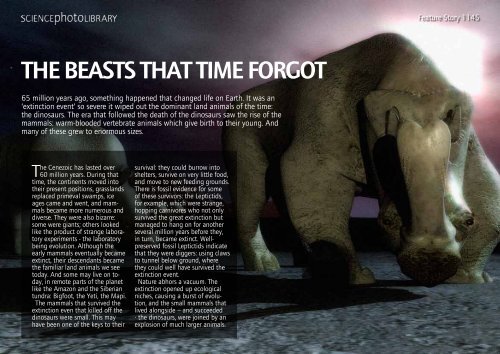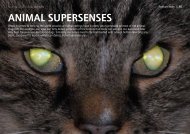Stories - Science Photo Library
Stories - Science Photo Library
Stories - Science Photo Library
- No tags were found...
Create successful ePaper yourself
Turn your PDF publications into a flip-book with our unique Google optimized e-Paper software.
Feature Story 1145THE BEASTS THAT TIME FORGOT65 million years ago, something happened that changed life on Earth. It was an‘extinction event’ so severe it wiped out the dominant land animals of the time:the dinosaurs. The era that followed the death of the dinosaurs saw the rise of themammals: warm-blooded vertebrate animals which give birth to their young. Andmany of these grew to enormous sizes.The Cenezoic has lasted over60 million years. During thattime, the continents moved intotheir present positions, grasslandsreplaced primeval swamps, iceages came and went, and mammalsbecame more numerous anddiverse. They were also bizarre:some were giants; others lookedlike the product of strange laboratoryexperiments - the laboratorybeing evolution. Although theearly mammals eventually becameextinct, their descendants becamethe familiar land animals we seetoday. And some may live on today,in remote parts of the planetlike the Amazon and the Siberiantundra: Bigfoot, the Yeti, the Mapi.The mammals that survived theextinction even that killed off thedinosaurs were small. This mayhave been one of the keys to theirsurvival: they could burrow intoshelters, survive on very little food,and move to new feeding grounds.There is fossil evidence for someof these survivors: the Leptictids,for example, which were strange,hopping carnivores who not onlysurvived the great extinction butmanaged to hang on for anotherseveral million years before they,in turn, became extinct. Wellpreservedfossil Leptictids indicatethat they were diggers: using clawsto tunnel below ground, wherethey could well have survived theextinction event.Nature abhors a vacuum. Theextinction opened up ecologicalniches, causing a burst of evolution,and the small mammals thatlived alongside – and succeeded- the dinosaurs, were joined by anexplosion of much larger animals.
<strong>Science</strong> <strong>Photo</strong> <strong>Library</strong> Feature <strong>Stories</strong> - Beasts That Time ForgotGiant herbivoresAbout 52 million yearsago, in what is now NorthAmerica, there appeared a2,000-kilo herbivore calledUintatherium. Resemblinga rhinoceros, Uintatheriumwas one of the largestanimals of its time - upto 4 metres long, withmassive limbs supportingan equally massivebody. Its equally massivehead featured three pairsof bony protrusions, likecut-down horns, and a pairof dagger-like tusks that itprobably used for protection.Uintatherium’s skull wasmostly bone, not brain, so ithad very limited intelligence- a quality that probablycontributed to its eventualextinction some 36 millionyears ago.Uintatherium’s cousins, theBrontotheres, were similarthick-skinned, rhino-likeherbivores that were upto 2.5 metres tall at theshoulder. Again, they hadstrange, horn-like structures- the exact purpose ofwhich is unknown - on theirsnouts. Yet these massivecreatures, which browsed inhuge herds across Asia andAmerica, had tiny brains nolarger than a fist and, liketheir Uintatherium cousins,died out 30 million yearsago.Even these massivecreatures would have beendwarfed by Indricotherium,which roamed the Asiansavannah until about 10million years ago. This herbivore, which stood 8metres tall from head to toe, is believed to havebeen the largest land mammal that ever lived: itweighed some 15 tonnes, twice that of today’slargest land animal, the African elephant.Fearsome predatorsThese herbivores were not the only large mammalsof the Cenezoic. They had meat-eatingcounterparts, like Hyaenadon. This predator,which possessed long, powerful jaws ideal forbiting and crushing, appeared about 41 millionyears ago. At 1.4 metres high at the shoulderand 3 metres in length, Hyaenadon, whichweighed up to 500 kilos, was one of the largestland carnivores that ever existed - apart fromAndrewsarchus.This was truly the stuff of nightmares.Andrewsarchus resembled an overgrown wolf:nearly two metres tall at the shoulder, nearly 5metres long, weighing over 1,000 kilos. Somemay have tipped the scales at 2,000 kilos –possibly the largest terrestrial carnivorousmammals that ever existed. Andrewsarchuswould have made a formidable adversary. Itshuge jaws – among the strongest ever evolvedin a land animal - could bite through the largestbones. So it was well-adapted to prey on thegiant herbivores.Early rodentsThough most fossil discoveries of the giant earlymammals were made in the 20th and 19thcenturies, palaeontologistscanstill come up withsurprise finds. In2000, a chancediscovery unearthedan almostcomplete skeleton of the world’s largest rodent.Phoberomys pattersoni, which probably lived onthe banks of Latin American rivers some 8 millionyears ago, resembles a guinea pig the sizeof a cow. This curious rodent stood one metretall, was three metres long - with a tail over ametre long - and weighed in at 700 kilos.So why are modern rodents so small comparedwith Phoberomys pattersoni?Small mammals such as rodents normallyescape predators by burrowing underground orrunning faster than their hunters. But Phoberomyspattersoni was too large to tunnel andtoo slow to run. It may simply have been toocumbersome to survive.The same is probably true of the other giantmammals of the early Cenezoic. Creatures likeIndricotherium, weighing in at some 15 tonnes,could not have moved very fast. They were atthe very limits of size for a land animal, andwould have been easy prey for predators. Others,like the rhino-like Uintatherium, with theirdagger-like tusks and thick skin, would not have
<strong>Science</strong> <strong>Photo</strong> <strong>Library</strong> Feature <strong>Stories</strong> - Beasts That Time Forgotbeen so easy. But their size alone meant theywere vulnerable to other factors like climatechange: animals which need to eat hundredsof kilos of food a day are totally dependent ontheir food supplies. If grasslands become dustbowls,those animals are doomed. Competitionwas another factor.Even the formidable Andrewsarchus, with itsbone-crushing jaws, eventually became extinct,possibly because it was simply too large, needingtoo much food to sustain itself. Eventually,it was out-competed by smaller, more efficientcarnivores - the ancestors of modern wolves,dogs and cats.Yet another factor was brain size. Typically,the early giant mammals had massive skullsbut small brains. They were probably incapableof adapting to new circumstances like changinggrazing lands simply because they weretoo dumb - the original ‘boneheads’ - and werereplaced by later, smarter mammals.Yet these extraordinary, super-sized creaturesmanaged to survive for millions of years. Eventhe Brontotheres, with brains no larger than afist, browsed the plains of the early Cenezoicfor nearly 30 million years before they becameextinct.The first horsesThe giants - though the most spectacular - werenot the only early mammals. They came inall sizes and shapes. Some were evolutionarydead-ends: Palaeotherium, for example, whichresembled a small tapir, became extinct 23 millionyears ago, leaving no trace save their fossilremnants. But others were early species that,over tens of millions of years, would evolve intotoday’s mammals. Eohippus, a herbivore thesize of a cat that grazed northern hemispheregrasslands over 50 million years ago, is thoughtby many scientists to be the ancestor of allmodern horses.Such is the slow pace of evolution that itwould take several million more years beforethe first equine ancestors that actuallylooked horse-like appeared. One of these wasMerychippus - though just 120 cm tall at theshoulder, it had a long muzzle and neck, ran inherds, and grazed. Merychippus itself gave riseto no fewer than 19 different species of grazers,which, millions of years later, eventually led tothe modern horse.Living alongside early humansIf the early mammals existed alongside thedinosaurs, then their later relatives livedalongside another dominant land species - man.The first hominids appeared about two millionyears ago; homo sapiens about 500,000 yearsago. Many of the strangest of the early mammalswere still alive during the early years ofman, only becoming extinct in the past severalthousand years. Some of them mayhave been hunted to extinction bythe new, large-brained, tool-using,two-legged mammals. And some ofthem may not be extinct, after all.The animals that shared the landwith the early humans were asstrange as their much earlier cousins.According to fossil evidence, Macrauchenia,an early hoofed animal,had what appeared to be a nose likean elephant’s trunk superimposedon the body of a goat. Yet this agile,speedy mammal was able to eludepredators for some seven millionyears, only becoming extinct 20,000years ago - so it may well have beena familiar sight to our distant ancestors.Another now-extinct early mammalthat definitely co-existed withhumans was the woolly rhinoceros.Its existence was, in fact, first knownfrom prehistoric cave drawings longbefore a well-preserved specimenwas found in a Polish tar-pit.The woollyrhinoceros’sname comesfrom the thickfur that allowed it tosurvive the last Ice Age- it has now been datedas late as 8,000 BC, tothe time of the StoneAge. It must have beena formidable adversaryfor Stone Age hunters:big, powerful, with a1-metre-long front hornthat could easily impalea human.The woolly rhinocerosis now extinct, probablyas a result of climatechange - the warmingworld after the Ice Age favoured its modern,fur-free cousins. But some of the early mammalsthat lived at the same time as humans maynot have followed the woolly rhinoceros intohistory. They - or creatures very similar to them- may live on in remote places like Amazonia orcentral Asia, giving rise to the legends of large,unknown beasts.Take the case of Megatherium, a relative oftoday’s tree sloth, but built on a much largerscale. Megatherium was about the size of anelephant, some six metres long and weighingup to four tonnes. This clumsy, slow-movingground sloth lived in the Americas until about12,000 years ago. Megatherium may have beena lumbering herbivore, but modern research hasshown the giant mammal was able to defenditself. By rearing up on its hind legs and displayingits dagger-like claws, Megatherium wouldhave been an intimidating adversary - like abear the size of an elephant.Modern day mythsDid some of these creatures survive extinctionand live on into modern times? Some researchersthink the answer is yes. In the 1890s, an
<strong>Science</strong> <strong>Photo</strong> <strong>Library</strong> Feature <strong>Stories</strong> - Beasts That Time ForgotArgentinean adventurer reported an encounterwith a large, hairy, unknown mammal. In fact, itwas so large that when he shot at it, his bulletsappeared to have no effect.Similar creatures have been described bylocal people over a wide area of Amazonia.They even have a name for it - the Mapinguari.Witnesses tell of a large, sloth-like creaturethat, when startled, rears up on its hind legs,shows its large claws and adopts an aggressivestance - just as Megatherium might have done.This may be rural legend, but villagers in areaswhere theMapinguarihas been reportedtakethe storiesseriouslyenough toavoid the forestat night.At least onezoologistbelieves the‘Mapi’ are,in fact, descendantsorrelatives ofgiant slothslike Megatherium.The averageweightof a malehumanEuropean isabout 80 kilos.The largestprimatethat everlived makeshumans lookpuny. Gigantopithecusweighedin at 500kilos andmeasured3 metres,two to threetimes thesize of today’s gorillas, which it superficiallyresembles. (in fact, its closest living relatives areorangutans). Gigantopithecus roamed southeastAsia for nearly one million years, before dyingout about 100,000 years ago. So it could haveco-existed alongside humans, to whom it wouldhave presented an awesome spectacle. Likegorillas, Gigantopithecus was a herbivore, feastingmainly on bamboo - which may have led toits demise as tropical jungle declined throughclimate change.But Gigantopithecus may not have died outentirely. Some researchers believe it still existsas the legendary primates known in variousplaces as Bigfoot and the Yeti. Whether that istrue or not, Gigantopithecus certainly playedone major role in modern times: its fossils werediscovered in the 1920s, leading to popularfascination - and a place in cultural history asthe basis for King Kong in the 1933 film classic.MammothsOf all the extinct mammals those paths crossedthose of humans, the most well-documentedand popular are the mammoths. We knowthey existed alongside humans - our ancestorspainted them on cave walls, often showingthem being hunted. And complete mammothshave been found beneath the frozen tundra ofSiberia. The mammoths were an extraordinarilysuccessful species. They survived for severalmillion years, and were widespread across theplanet.Mammoth remains have been found inEurope, Africa, Asia and north America. Theirthick coats allowed them to thrive during theIce Ages: their population density in Siberiaalone has been estimated at 60 mammoths toevery 100 square kilometres. Most mammothswere about the same size as today’s Indianelephants. But some were much larger: theImperial Mammoths of California weighed over8 tons and reached heights of over 4 metres.Most mammoths died out at the end of thelast Ice Age, about ten thousand years ago. Nooneknows for sure why they became extinct. Itwas probably a combination of several factors- a warming Earth; hunting by humans; anddisease. Yet some survived into relatively recenttimes. Remains of smaller versions, called ‘dwarfmammoths’, have been found on remote islandsand dated to just 1,500 BC. And, like Gigantopithecus,there are claims that mammoths maystill exist. Reports by Siberian tribesmen suggestthat small groups of them may still exist in thevastness of the tundra.Even if the great mammoths are truly extinct,it may be possible to ‘revive’ them. It’s notbeyond the realms of possibility that scientistscould create an animal similar to the mammoth.Take DNA from a well-preserved male mammothcorpse, recreate its sperm, and use thatto impregnate a female Indian elephant - themammoth’s closest living relative. This wouldbe difficult, to say the least, but some scientistsbelieve it is possible, and far more realisticthan trying to recreate a dinosaur. Just recently,in December 2005, researchers managed tocomplete a section of mammoth DNA called‘mitochondrial DNA’, which is passed down thegenerations via the female line. So re-creatingmammoth sperm may not be as outrageous asit sounds.The early mammals of the Cenezoic - thebeasts that time forgot - had as much animpact on their surroundings as the dinosaursthey replaced. Their cousins - the mammals thatfollowed them - are still the dominant animalson land. And if it were possible to create aCenezoic Park, its inhabitants would be justas bizarre, and fascinating, as the dinosaurs ofJurassic Park.ENDS 2450 WDSWritten by Jon Trux© SCIENCE PHOTO LIBRARY 2006
FULL PICTURE SETFor captions and credits, please refer to the captions.txt file<strong>Science</strong> <strong>Photo</strong> <strong>Library</strong> Feature <strong>Stories</strong> - Beasts That Time ForgotFor further information, please contact: seymour@sciencephoto.comAll images are copyright, please credit images as stated on the captions
















